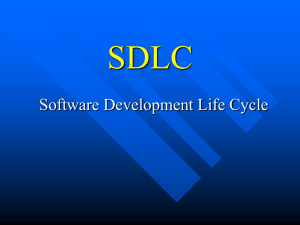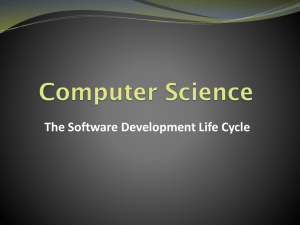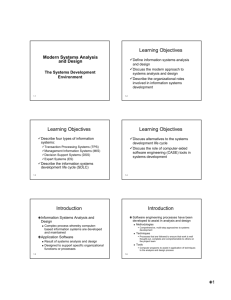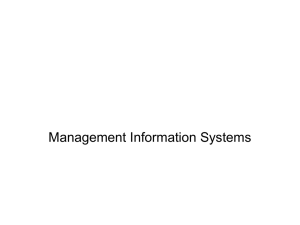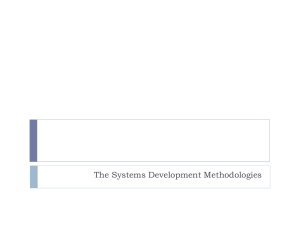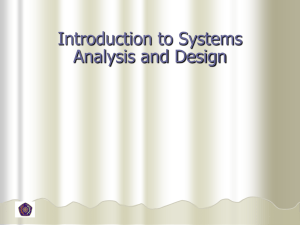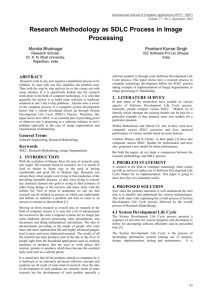Name : ______________ Version 2 INSC 20263 Test #1
advertisement
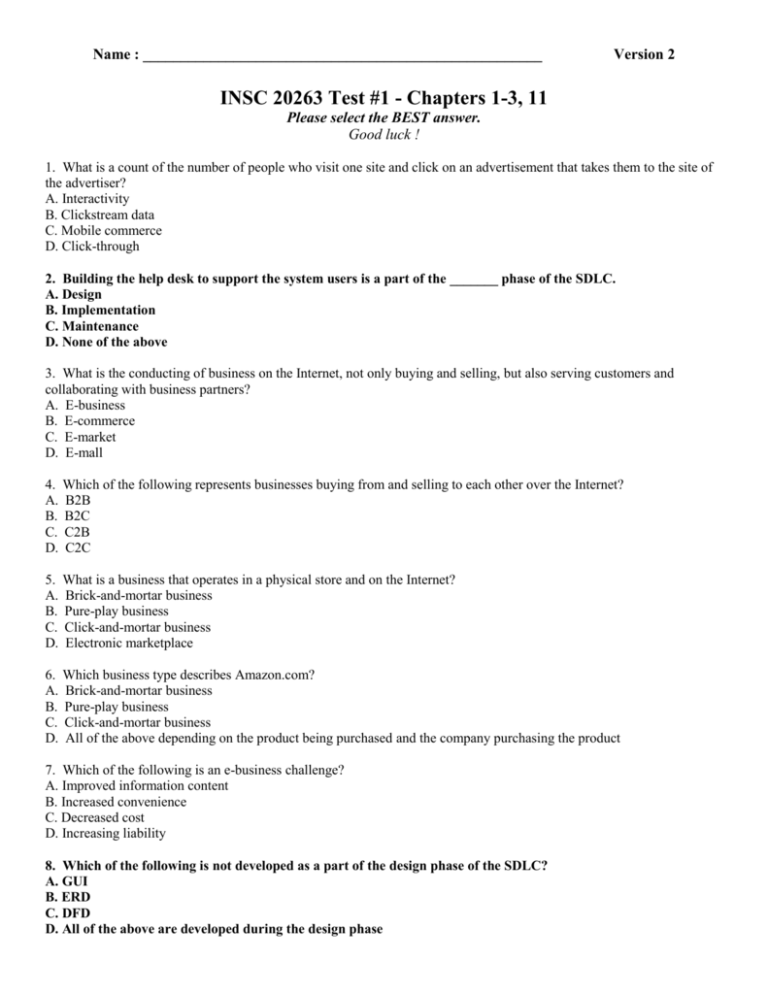
Name : _____________________________________________________ Version 2 INSC 20263 Test #1 - Chapters 1-3, 11 Please select the BEST answer. Good luck ! 1. What is a count of the number of people who visit one site and click on an advertisement that takes them to the site of the advertiser? A. Interactivity B. Clickstream data C. Mobile commerce D. Click-through 2. Building the help desk to support the system users is a part of the _______ phase of the SDLC. A. Design B. Implementation C. Maintenance D. None of the above 3. What is the conducting of business on the Internet, not only buying and selling, but also serving customers and collaborating with business partners? A. E-business B. E-commerce C. E-market D. E-mall 4. Which of the following represents businesses buying from and selling to each other over the Internet? A. B2B B. B2C C. C2B D. C2C 5. What is a business that operates in a physical store and on the Internet? A. Brick-and-mortar business B. Pure-play business C. Click-and-mortar business D. Electronic marketplace 6. Which business type describes Amazon.com? A. Brick-and-mortar business B. Pure-play business C. Click-and-mortar business D. All of the above depending on the product being purchased and the company purchasing the product 7. Which of the following is an e-business challenge? A. Improved information content B. Increased convenience C. Decreased cost D. Increasing liability 8. Which of the following is not developed as a part of the design phase of the SDLC? A. GUI B. ERD C. DFD D. All of the above are developed during the design phase 9. Which of the following is not a valid type of e-marketplace revenue model? A. Loyalty fee B. Subscription fee C. Advertising fee D. Transaction fee 10. Which of the following is not one of Porter’s Five Forces? A. Buyer power B. Supplier power C. Threat of substitute buyers D. Rivalry among existing competitors 11. Which of the following represents supplier power in Porter’s Five Forces Model? A. High when buyers have few choices of whom to buy from and low when their choices are many B. Low when buyers have few choices of whom to buy from and high when their choices are many C. High when buyers have many choices of whom to buy from and low when their choices are few D. None of the above 12. What is an auction format in which increasingly lower bids are solicited from organizations willing to supply the desired product or service at an increasingly lower price? A. Reverse auction B. Private exchange C. Private auction D. Reverse exchange 13. All of the following are part of Porter’s Three Generic Strategies, except: A. Broad cost leadership B. Broad differentiation C. Focused strategy D. Business process strategy 14. Which part of the value chain acquires raw materials and manufactures, delivers, markets, sells, and provides aftersales services? A. Primary value activities B. Secondary value activities C. Support value activities D. None of the above 15. What are the measures called that are tied to business drivers? A. IT efficiency B. IT effectiveness C. Key performance indicators D. None of the above 16. What do most companies measure to determine the success of their Web sites? A. Throughput B. Transaction speed C. Traffic D. System availability 17. Which of the following activities does a CIO perform? A. Oversees all uses of information technology B. Ensures the strategic alignment of IT with business goals C. Ensures the strategic alignment of IT with business objectives D. All of the above Page 2 of 6 18. What can IT enable an organization to accomplish? A. Reduce costs B. Improve productivity C. Generate growth D. All of the above 19. What is data that has been converted into meaningful and useful context? A. Information B. Information technology C. Information systems D. All of the above 20. Which information culture can cause an organization to have a great degree of difficulty operating? A. Information-functional culture B. Information-sharing culture C. Information-inquiring culture D. Information-discovery culture 21. Which of the following is not one of Thomas Friedman’s 10 forces that flattened the world? A. Netscape IPO B. Fall of the Berlin wall C. Microsoft IPO D. Wireless 22. What did Thomas Friedman believe happened to the world because of the unplanned cascade of technological and social shifts? A. The world became bigger B. The world became flat C. The world became larger D. The world became more sophisticated 23. What is a competitive advantage? A. A product that an organization’s customers place a lesser value on than similar offerings from a competitor B. A product or service that an organization’s customers value more highly than similar offerings from a supplier C. A service that an organization’s customers place a lesser value on than similar offerings from a supplier D. A product or service that an organization’s customers place a greater value on than similar offerings from a competitor 24. What is the acquisition and analysis of events and trends in the environment external to an organization? A. Private exchange B. First-mover advantage C. Environmental scanning D. Loyalty program 25. _____ conversion is the process where the new system is introduced in one part of the organization. A. Parallel B. Pilot C. Direct D. Phased 26. Which of the following is an organizational result from an effective and efficient supply chain management system? A. Decrease the power of its buyers B. Create entry barriers thereby reducing the threat of new entrants C. Increase efficiencies while seeking a competitive advantage through cost leadership D. All of the above Page 3 of 6 27. What is a category of AI that attempts to emulate the way the human brain works? A. Neural network B. Artificial intelligence C. Expert systems D. Intelligent system 28. A. B. C. D. _____ is a group-based approach for collecting user requirements. Integrated CASE RAD JAD None of the above 29. Which of the following represents the top-down (executives to analysts) organizational levels of information technology systems? A. TPS, DSS, EIS B. DSS, TPS, EIS C. EIS, DSS, TPS D. None of the above, it varies from organization to organization 30. Which of the following is an example of transactional information? A. Withdrawing cash from an ATM B. Making an airline reservation C. Purchasing stock D. All of the above 31. Which of the following systems would best assist a production manager wishing to minimize the cost of production, given information about amounts of raw materials and labor available and their prices? A. Decision Support System B. Expert System C. Transaction Processing System D. None of the above. 32. Which of the following are disadvantages of the buy option for acquiring IS applications? a. Software may not exactly meet the company’s needs b. Software may be impossible to modify c. Software may not integrate with existing systems d. All of the above 33. What is the second step in SDLC? A. Analysis B. Planning C. Design D. None of the above 34. What is the Internet standard that supports the exchange of information on the WWW? A. Protocol B. FTP C. HTTP D. Internet Page 4 of 6 35. Which of the following systems development methods helps clarify user requirements, promotes genuine user participation, and produces a prototype? A. Waterfall methodology B. Rapid application development C. End-user development D. Extreme programming 36. What is CRM? A. A strategy B. A technology C. Both a technology and a strategy D. Neither a technology nor a strategy 37. What is a business process? A. The analysis and redesign of workflow within and between enterprises B. A standardized set of activities that accomplish a specific task, such as processing a customer’s order C. Integrates all departments and functions throughout an organization into a single IT system so that employees can make decisions by viewing enterprisewide information on all business operations D. None of the above 38. What is enterprise resource planning? A. The analysis and redesign of workflow within and between enterprises B. A standardized set of activities that accomplish as specific task, such as processing a customer’s order C. Integrates all departments and functions throughout an organization into a single IT system so that employees can make decisions by viewing enterprisewide information on all business operations D. Involves managing all aspects of a customer’s relationship with an organization to increase customer loyalty and retention and an organization’s profitability 39. Which of the following is a quantitative model typically used by a DSS? A. Sensitivity analysis B. What-if analysis C. Goal-seeking analysis D. All of the above 40. What is drill-down capability? A. Involves the aggregation of information and features simple roll-ups to complex groupings of interrelated information. B. The ability to look at information from different perspectives C. Enables users to get details, and details of details, of information D. Finds the inputs necessary to achieve a goal such as a desired level of output 41. What is slice-and-dice capability? A. Involves the aggregation of information and features simple roll-ups to complex groupings of interrelated information. B. The ability to look at information from different perspectives C. Enables users to get details, and details of details, of information D. Finds the inputs necessary to achieve a goal such as a desired level of output 42. What integrates information from multiple components and tailors the information to individual preferences? A. Digital dashboard B. Sensitivity analysis C. What-if analysis D. Drill-down Page 5 of 6 43. What is the success rate for a project using the waterfall methodology? A. 70% B. 50% C. 25% D. 10% 44. Which of the following statements is INCORRECT? A. Waterfall methodology implements SDLC phases sequentially. B. Using the right implementation methodology is critical to successful system development, but employee involvement is not critical. C. Evaluating project feasibility is a part of the planning phase of the SDLC. D. XP methodology develops a system in iterations 45. What is a kiosk? A. The B2B purchase and sale of supplies and services over the Internet B. Involves buying through prenegotiated contracts with qualified suppliers C. A company that provides individuals and other companies access to the Internet along with additional related services, such as Web site building D. A publicly accessible computer system that has been set up to allow interactive information browsing 46. What is an ISP? A. The B2B purchase and sale of supplies and services over the Internet B. Involves buying through prenegotiated contracts with qualified suppliers C. A company that provides individuals and other companies access to the Internet along with additional related services, such as Web site building D. A publicly accessible computer system that has been set up to allow interactive information browsing 47. What is a Web site in which items are posted on a regular basis and displayed in reverse chronological order? A. RSS B. Podcasting C. SEO D. Blog 48. What is an associate or affiliate program? A. A box running across a Web page that is often used to contain advertisements B. Allows businesses to generate commissions or royalties from an Internet site C. A technique that induces Web sites or users to pass on a marketing message to other Web sites or users D. The ability of an organization to give its customers the opportunity to tailor products or services to customer’s specifications 49. What is viral marketing? A. A box running across a Web page that is often used to contain advertisements B. Allows businesses to generate commissions or royalties from an Internet site C. A technique that induces Web sites or users to pass on a marketing message to other Web sites or users D. The ability of an organization to give its customers the opportunity to tailor products or services to customer’s specifications 50. The SDLC methodology that involves a lot of team coding is: A. Waterfall B. RAD C. XP D. None of the above Page 6 of 6
